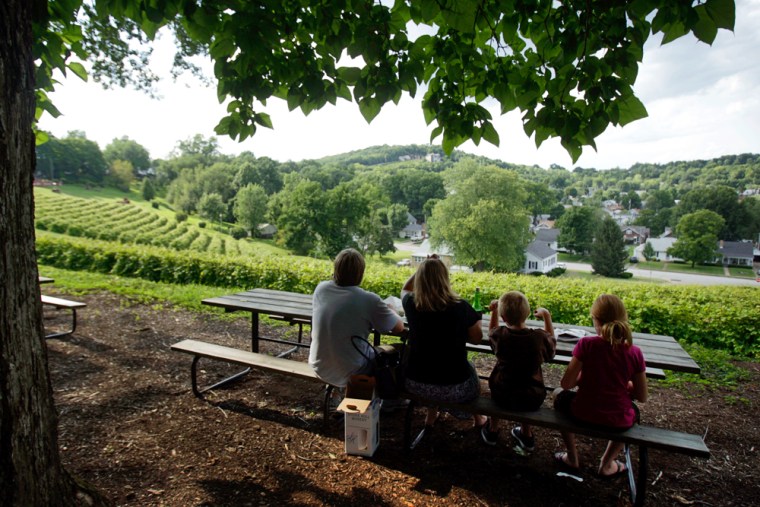The 19th century German settlers who saw visions of the Rhineland in the rolling Missouri hills likely didn't anticipate the more modern voyagers who flock to these parts: Spandex-wearing, energy-bar-chowing cyclists lured by a 236-mile rails-to-trails path — the nation's longest.
What they instead discovered was fertile farmland ideal for growing grapes while hardy enough to endure the extremes of Missouri weather.
For Katy Trail riders, the abundance of wineries in what before Prohibition was the nation's second-largest wine-producing region makes for a memorable two-wheeled vacation.
An added bonus for bicycling history buffs: much of the trail parallels the Missouri River and covers ground first explored more than 200 years ago by frontier pioneers Meriwether Lewis and William Clark.
The Katy (named for the old Missouri-Kansas-Texas Railroad, or MKT for short) is actually a state park. Each summer, the Missouri Department of Natural Resources sponsors a weeklong ride for several hundred cyclists from across the country.
DNR employee and tour leader David Kelly called the event "an entry-level ride for folks interested in touring." The youngest rider this year was 6; the oldest 80, with an average age of 52.
The cross-state trail is almost entirely flat, and daily rides don't top 60 or 65 miles on the hard-packed gravel surface. With charming, history-drenched railroad towns every eight to 10 miles along the trail, the event is aptly named: Cruisin' on the Katy.
"It's not a race," Kelly said. "Usually, we have to chase them out of shops and restaurants."
Rather than a week's ride, I opted for an abbreviated, two-day tour that began in Hermann and concluded a mere 65 miles away in St. Charles.
Hermann is the heart of Missouri's Germanic influence, a settlement founded in 1837 by those seeking religious freedom, cheap land and an escape from high taxes, crop failures, overpopulation and the ravages of the Napoleonic War.
By 1870, one-third of Missouri's 1.7 million residents were German, with another 11,000 hailing from Austria and Switzerland. They settled in small towns such as Dutzow, Rhineland, Bernheimer, Berger and Holstein.
Churches and schools conducted services and lessons in German. At the turn of the century, the state boasted three daily German-language newspapers, 25 weeklies and 12 monthly publications.
World War I, though, brought a backlash that led the Missouri Council of Defense to order the "elimination of enemy language and influence." Two counties even banned German speech over the telephone.
The state's wine industry boomed with its German settlements. More than 60 wineries sprung up in the Missouri River valley. The largest was Hermann's Stone Hill Winery, which opened in 1847 and claims to have once been one of the largest wineries in the world.
That changed with the arrival of Prohibition, when government agents destroyed Stone Hill's carefully cultivated grapes and winemaking equipment and dumped its wine into the nearby river.
Pig farmer Jim Held reopened the winery in 1965, and it has reclaimed its title as one of the state's largest. Set atop a Hermann hillside, Stone Hill is a popular site for weddings and a destination for day-trippers from St. Louis and Kansas City.
The hourly tours of its arched wine cellars (at 55 degrees, a welcome respite for Katy Trail cyclists laboring in the 95-degree heat during this year's group ride) culminate in a tasting room visit.
The signature variety — and the state's official grape — is called norton, a dry red wine less well known than such staples as chardonnay and cabernet sauvignon. Stone Hill's version, which ages five to eight years, is just one of the bottles that have elevated winemaking into a $30 million-a-year industry for the state.
The town of Augusta, population 300 and located 35 miles east of Hermann along the Katy, also basks in a rich viticultural history.
In 1980, Augusta gained designation by the federal Bureau of Alcohol, Tobacco and Firearms as the country's first American Viticultural Area — eight months before California's Napa Valley received the same honor.
Several wineries surround the area, but the most convenient stop for Katy Trail cyclists is the Augusta Brewing Co., which rests beside the trail.
The brewpub serves an array of staples and seasonal beers, from fruity Hefeweizen to cloudy, full-bodied stouts. Like many of the region's wineries, live music can be seen at an outdoor beer garden, primarily on weekends.
Not every thirst-quenching stop along the Katy caters to wine aficionados or self-appointed beer snobs. One of the most memorable beverage breaks on our abbreviated trip was of the decidedly downscale variety.
Most car travelers passing through the whistlestop town of Treloar wouldn't give its unassuming tavern a second glance. But the promise of a frozen ice cream sandwich (the best dollar spent on this trip) lured us inside.
By 10 a.m., several other cyclists had saddled up to the bar, cold Budweisers in hand. Mounted deer heads and stuffed pheasants lined the walls alongside neon beer signs and huge NASCAR posters. Bogey, a 6-year-old black Labrador and the unofficial "mayor of Treloar," presided over the scene with a droopy stare.
Like just about any Katy Trail stop, the Treloar Bar and Grill teemed with its own history. Founded in 1904 by German immigrant Henry Hasenjaeger, the pub remained in his family for several generations. Old photos of the Hasenjaeger family were dutifully preserved on display in the bar's back room.
For the more ambitious traveler, the Katy Trail extends west of Hermann to the state capital of Jefferson City, the college town of Columbia and the French settlement of Rocheport.
The stretch of trail between Jefferson City and Rocheport offers soaring limestone bluffs and some stunning river views. More wineries and brewpubs can be found in and near each of those cities. So sip away.
